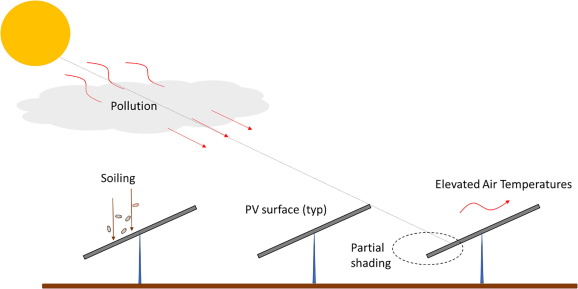Scientists from Arizona State University have conducted research to evaluate how urban settings affects the performance of PV systems and, conversely, how PV systems affect their surrounding urban environment.
The researchers explained that solar modules are sources of radiative heat for all structures beneath them and, at the same time, are convective heat sources that can considerably increase the temperature of the ambient air in cities, contributing to the so-called urban heat island (UHI) effect, which occurs when cities absorb and retain heat, due to a high concentration of pavements, buildings, and other surfaces.
Their analysis was based on a review conducted on 116 scientific articles for review, through which seven different types of PV-urban climate interactions were identified. For the impact of the urban environment on the PV system, it considered urban air temperature, urban air pollution, the partial shading of the PV system, and soiling. To evaluate how the solar array affects the urban environment, it took into account urban air temperatures, building heating and cooling loads, and outdoor shade.
Impact of urban environment
The scientists found that all analyzed parameters have a “non-trivial role” in affecting PV power generation, although the impact of the elevated temperatures caused by the UHI is difficult to quantify, as it varies seasonally and diurnally.
Air pollution was described as one of the main factors reducing PV performance in urban environments, with power yield spanning from 5 to 15%. “Particle deposition on PV panels results in absorption and backscattering of insolation, reducing the transmittance of the panel surface,” the academics explained. “While this effect is most notable in highly polluted urban environs, it can also manifest itself in rural installations downwind of urban and industrial pollution sources.”

Image: Energy and Buildings, Elsevier, Creative Commons license CC BY 4.0, https://bit.ly/3AKRH20
As for the effect of soiling, the scientists said that cities often have impervious surfaces such as roads, parking lots, and buildings, which are not detrimental to PV power generation, as these are less prone to high atmospheric loading of particulates from soils. “Nevertheless, other sources of soiling in urban environments, including soot from vehicles and industry and dust from construction activities may significantly contribute to soiling of PV,” they further explained. “However, research suggests that periodic cleaning of PV surfaces, either from precipitation or from routine maintenance can maintain the generation penalty of soiling at less than 10%.”
The shading effect, which for PV systems in urban environments is often unavoidable, is described in the study as the most significant issue affecting PV system performance in dense urban areas. “The average effects of this penalty can be on the order of 20%,” the researchers emphasized. “However, careful design of urban installations, accounting for current, and potential future shading, can greatly reduce this issue.”
Impact of photovoltaics
The analysis of how PV impacts the urban environment showed conflicting results and highlighted the need for further studies, although it confirmed that solar panels have an influence on urban energy balance and affect urban air temperatures.
Their thermal and electrical characteristics are key parameters to assess this influence. The shadow that the panels can produce on the surrounding areas and air gap between the panels and the surface beneath them, which results in convective heat transfer from both surfaces of the PV panel to the air, were identified as two main factors increasing air temperature. “Further controlled empirical studies and validated modeling efforts are needed, particularly because the conflicting studies differ not simply in magnitude of their projections, but in terms of the sign of the anticipated impact of PV on air temperatures,” they further explained.
Their analysis also showed that current scientific literature is also divided on how rooftop PV positively affects the energy performance of buildings by reducing the need for cooling at night, taking into account that solar panels can cool down faster than the roof cover or other architectural elements. “The magnitude of this savings depends significantly on the assumption of the albedo of the roof surface being shaded, the level of building insulation, and other building construction and operation characteristics,” the also stated.
“As our synthesis suggests, photovoltaics in urban settings offer many benefits, but also are fraught with challenges — both in terms of how the urban environment affects their performance and how they can adversely affect the urban environment and energy consumption for air conditioning,” they concluded. “These complexities are often difficult to convey to the general public or to local/regional decision-makers who are typically seeking simplified summaries regarding the evaluation of technologies.”
Their findings were presented in the paper “Photovoltaics in the built environment: A critical review,” published in Energy and Buildings.
This content is protected by copyright and may not be reused. If you want to cooperate with us and would like to reuse some of our content, please contact: editors@pv-magazine.com.








By submitting this form you agree to pv magazine using your data for the purposes of publishing your comment.
Your personal data will only be disclosed or otherwise transmitted to third parties for the purposes of spam filtering or if this is necessary for technical maintenance of the website. Any other transfer to third parties will not take place unless this is justified on the basis of applicable data protection regulations or if pv magazine is legally obliged to do so.
You may revoke this consent at any time with effect for the future, in which case your personal data will be deleted immediately. Otherwise, your data will be deleted if pv magazine has processed your request or the purpose of data storage is fulfilled.
Further information on data privacy can be found in our Data Protection Policy.